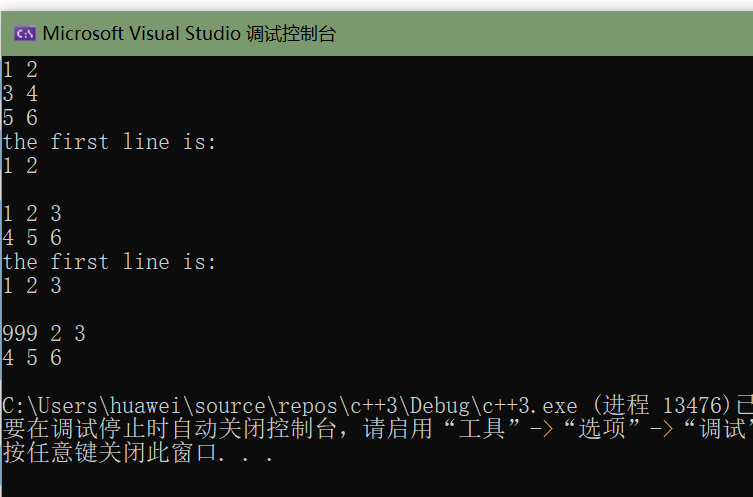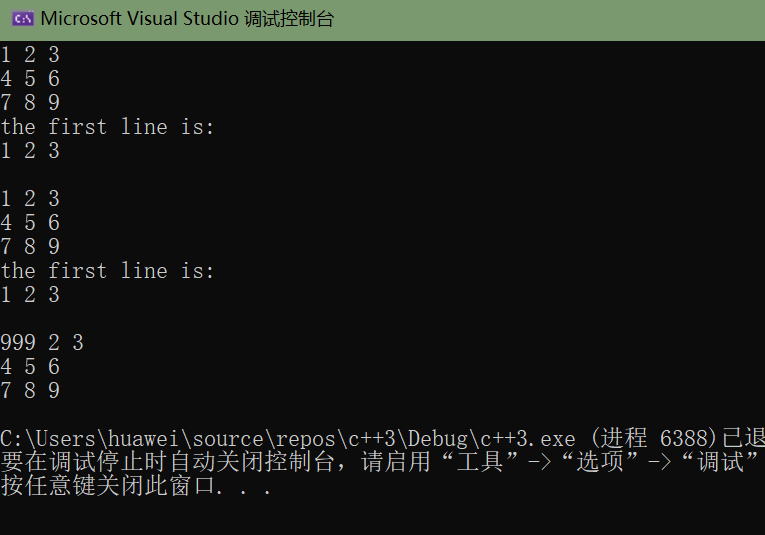实验三
task4.hpp
#include <iostream> using std::cout; using std::endl; class Vector_int { public: Vector_int(int n); Vector_int(int n,int m); ~Vector_int(); Vector_int(Vector_int& X); void print(); int& at(int i); private: int size; int* p; }; Vector_int::Vector_int(int n) { p = new int[n]; size = n; cout << "constructor called." << endl; } Vector_int::Vector_int(int n, int m) { p = new int[n]; for (int i = 0; i < n; i++) p[i] = m; size = n; cout << "constructor called." << endl; } Vector_int::~Vector_int() { delete[] p; cout << "Destructor called." << endl; } Vector_int::Vector_int(Vector_int& X) { size = X.size; p = new int[X.size]; for (auto i = 0; i < size; ++i) p[i] = X.p[i]; } int& Vector_int::at(int i) { return p[i]; } void Vector_int::print() { for (auto i = 0; i < size; ++i) cout << p[i]<<" "; cout << endl; }
task4.cpp
#include<iostream> #include"Vector.hpp" int main() { Vector_int x(4,9); Vector_int y(x); y.print(); y.at(0) = 999; y.print(); }
运行截图:

task5.hpp
#ifndef MATRIX_H #define MATRIX_H #include <iostream> #include <cassert> class Matrix { public: Matrix(int n); // 构造函数,构造一个n*n的矩阵 Matrix(int n, int m); // 构造函数,构造一个n*m的矩阵 Matrix(const Matrix& X); // 复制构造函数,使用已有的矩阵X构造 ~Matrix(); //析构函数 void set(const double* pvalue); // 用pvalue指向的连续内存块数据为矩阵赋值 void set(int i, int j, int value); //设置矩阵第i行第j列元素值为value double& at(int i, int j); //返回矩阵第i行第j列元素的引用 double at(int i, int j) const; // 返回矩阵第i行第j列元素的值 int get_lines() const; //返回矩阵行数 int get_cols() const; //返回矩列数 void print() const; // 按行打印输出矩阵 private: int lines; // 矩阵行数 int cols; // 矩阵列数 double* p; // 指向存放矩阵数据的内存块的首地址 }; Matrix::Matrix(int n) { lines = n; cols = n; p = new double[n * n]; } Matrix::Matrix(int n, int m) { lines = n; cols = m; p = new double[n * m]; } Matrix::Matrix(const Matrix& X) { lines = X.lines; cols = X.cols; p = new double[lines*cols]; for (int i = 0; i < lines; i++) for (int j = 0; j < cols; j++) p[cols * i + j]=X.p[cols * i + j]; } Matrix::~Matrix() { delete[] p; } void Matrix::set(const double* pvalue) { for (int i = 0; i < lines; i++) for (int j = 0; j < cols; j++) p[cols * i + j] = *pvalue++; } void Matrix::set(int i, int j, int value) { p[cols * i + j] = value; } double& Matrix::at(int i, int j) { return p[cols * i + j]; } double Matrix::at(int i, int j) const { return p[cols * i + j]; } int Matrix::get_lines() const { return lines; } int Matrix::get_cols() const { return cols; } void Matrix::print() const { for (int i = 0; i < lines; i++) { for (int j = 0; j < cols; j++) std::cout<<p[cols * i + j]<<" "; std::cout << std::endl; } } #endif
task5.cpp
#include <iostream> #include "matrix.hpp" int main() { using namespace std; double x[] = { 1, 2, 3, 4, 5, 6 }; Matrix m1(3, 2); // 创建一个3×2的矩阵 m1.set(x); // 用一维数组x的值按行为矩阵m1赋值 m1.print(); // 打印矩阵m1的值 cout << "the first line is: " << endl; cout << m1.at(0, 0) << " " << m1.at(0, 1) << endl; cout << endl; Matrix m2(2, 3); m2.set(x); m2.print(); cout << "the first line is: " << endl; cout << m2.at(0, 0) << " " << m2.at(0, 1) << " " << m2.at(0, 2) << endl; cout << endl; Matrix m3(m2); m3.set(0, 0, 999); m3.print(); }
运行截图:





 浙公网安备 33010602011771号
浙公网安备 33010602011771号